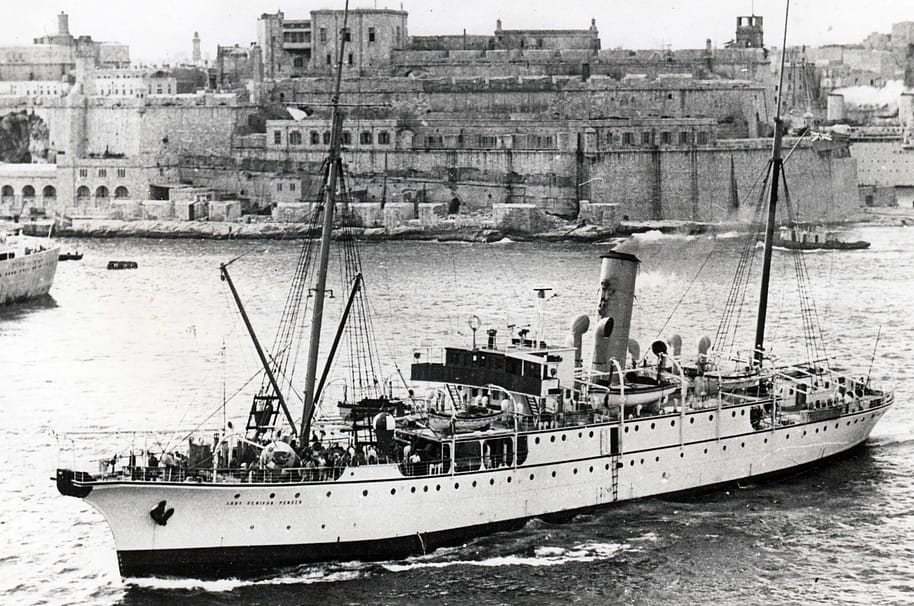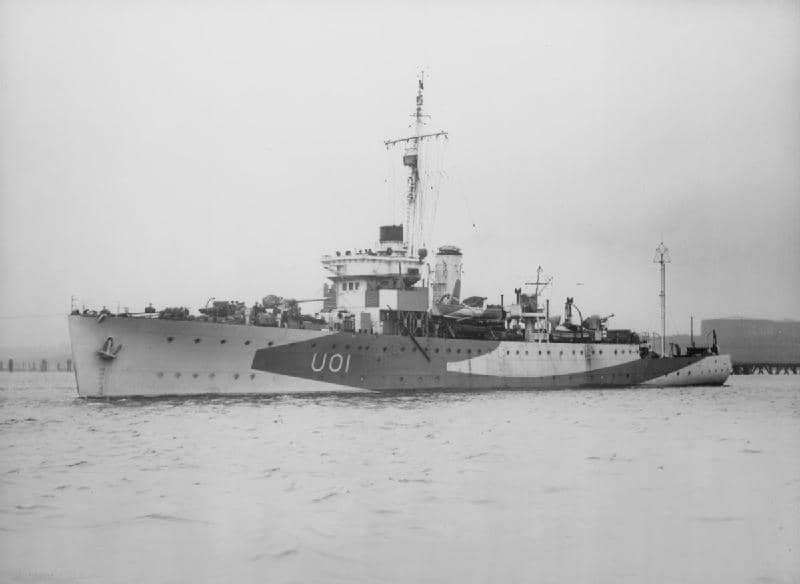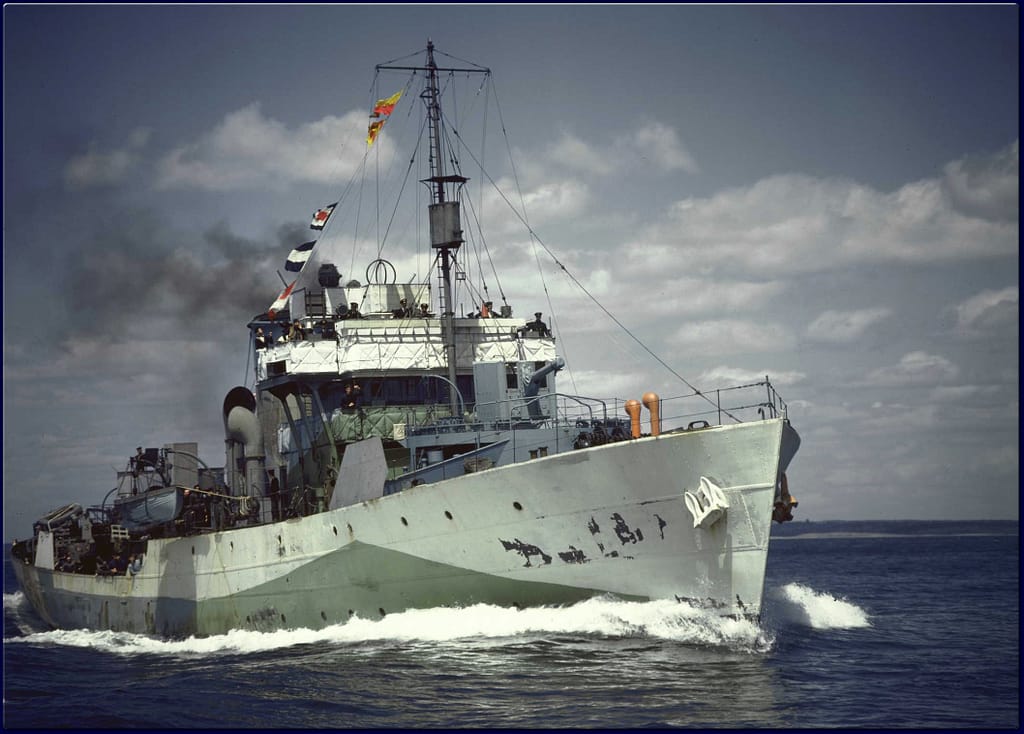The Lady and the Wolfpack
It is a sunny day in 1943, and a flotilla of ships, some of them armed, are steaming south-south-west across a sea of deep blue. Many miles off their port beam, below the eastern horizon and so out of sight, are the golden sands of Spanish Sahara. It is a Sunday; the air is warm and the crews of these ships are watchful. Leading the flotilla is a cableship, the twin-screw Lady Denison-Pender.
They are blissfully unaware that they are sailing into the deadly arms of a U-boat wolfpack.
The Lady Denison-Pender: lady of the cable
In 1920, the Fairfield Ship Building & Engineering Company of Glasgow completed their latest ship for the Eastern Telegraph Company. The Lady Denison-Pender was built as a cable repair ship. Triple-expansion steam engines, twin screws, three cable tanks, and 1,984 gross registered tonnes, the Lady Denison-Pender was 269 feet or about 82 metres in length, with a beam of 38 feet or 11.5 metres, and a draught exceeding 23 feet or 7 metres. It had clean, elegant lines.
The new cable-ship was based in Aden, and its sphere of work encompassed the submarine cables of the Indian Ocean. In 1929, it was transferred into the fleet of the newly formed Imperial & International Communications Limited, later to be called Cable & Wireless. (More on the Lady Denison-Pender can be found at our YouTube channel here [https://www.youtube.com/watch?v=6skzh5EjZ-Y].)

The Second World War Begins
In 1938, the Lady Denison-Pender was moved to the West Indies, and with a crew of St Helena men, it worked at repairing cables up until the out-break of the Second World War, when suddenly the repairing of submarine cables became decidedly more hazardous.
The Lady Denison-Pender returned to Aden in 1940, but its duties were interrupted on 11th June by the Italian air force, who paid the skies over Aden a very unwelcome visit. The cable repair ship escaped damage, and with more raids on Aden being made, it was transferred to the Atlantic.
It was the Lady Denison-Pender that cut the French cables between Brest and Dakar, and diverted the Malaga-Azores cable, and even laid the 1943 Gibraltar-Madeira cable. It was after this that the Lady Denison-Pender joined Convoy RS-3.

Attack of the ‘Pirates’
In late March, 1943, having worked on the Gibraltar-Madeira cable, the Lady Denison-Pender set course for Freetown, Sierra Leone. It sailed in a convoy, RS-3, as its commodore, leading the convoy. The convoy was protected by two corvettes and two armed trawlers. According to the Admiralty War Diaries, these escorts were the 1,000-ton HMS Burdock, a flower-class corvette, and the 1,045-ton HMS Bridgewater, the lead ship of the Bridgewater-class sloops. The tugs were the Empire Denis and the Empire Ace. The voyage seemed destined to be an uneventful one. But off the coast of Spanish Sahara, one of the convoy ships, the 5,400-ton Lagosian, was suddenly torpedoed.
Image: HMS Burdock
The convoy had sailed straight into a U-boat wolf-pack called the Seeräuber (‘pirates’), made up of seven U-boats – the U-67, the U-123, the U-159, the U-167, the U-172, the U-513, and the U-515 – and now the convoy was being stalked. It was no accident they encountered this particular wolfpack. The Seeräuber had been warned of the convoy and had formed a patrol line. They knew of the three merchantmen, they knew of the tugs, and they knew of the ‘valuable cable-layer ship’.
First blood had gone to the U-167, under the command of Kurt Sturm. The 275-ton tug Empire Denis hurried to rescue the 39 survivors of the Lagosian, and the convoy escorts went to work, hunting for the U-boats whilst the convoy hurried on, zigging and zagging.

One By One . . .
Two hours later, with the escorts some seven miles astern, the 5,300-ton, Silver Line-owned Silver Beech was hit by the U-159 under the command of Helmut Witte, and the cargo of ammunition and explosives the Silver Beech was carrying exploded, killing 59 of its 67 crew (including its master, Mr Thomas George Hyem). The explosion blasted debris high into the sky and some of this fell on to the Lady Denison-Pender. The commander of the Bridgewater at first believed the convoy had run into a minefield as the water depth was only 120 fathoms and so not conducive to U-boat operations. But he was wrong and soon realised it.
Image: HMCS Regina, a sister-ship of HMS Burdock
The afternoon saw the return of the escorts and a third attack, but this time the escorts spotted a U-boat’s periscope. A torpedo passed under the Lady Denison-Pender’s stern, and the Bridgewater and the Burdock launched depth-charge after depth-charge. There was a pause, but that night the U-172 under Carl Emmermann struck, and the Belgian ship Moanda reported she had been hit by a torpedo and was on fire. The Burdock stood-by, but by morning light there was no sign of the Moanda, not even wreckage.
By now only the Lady Denison-Pender and two tugs were left, and they increased speed. The cableship was still afloat and her commander was determined to keep it that way, and so what was left of convoy RS-3 hurried to Bathurst, arriving on Wednesday 31st March, having survived a close-call.
Author
Duncan S. Mackenzie, RITTech, AMBCS
Digital Collections Officer, PK Porthcurno
Header image: Lady Denison-Pender on its sea-trials
